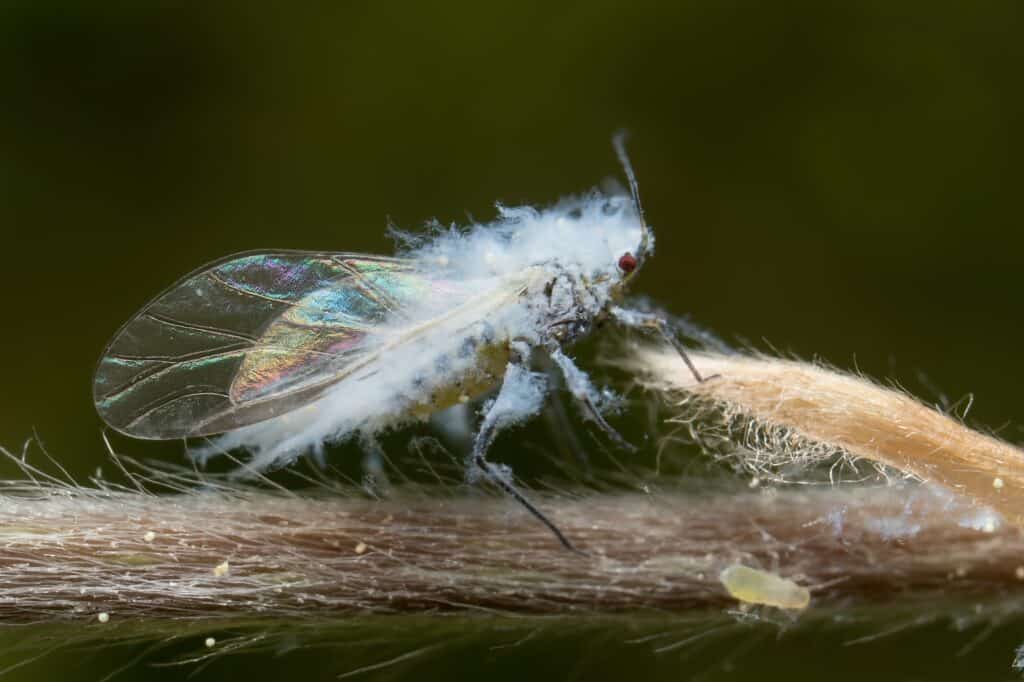

Spring-feeding damage by woolly apple aphids causes shoots to form rosette-like structures comprised of curled, twisted, and stunted leaves. The affected leaves overlap producing cavities where the aphids live and feed. Although the leaf distortions appear to be random, opening the structure may reveal striking spiral or pinwheel patterns produced by the leaf veins. The woolly apple aphid can alternate between American elms and members of the rose family (Rosaceae). Of course, as its common name implies, the aphid is a major pest of apples where they form damaging colonies on both the shoots and roots. Interestingly, various online university resources note that with the loss of American elms, this aphid demonstrated the ability to maintain damaging populations on rosaceous hosts.

The woolly apple and elm aphids are native insects that appear in pest records dating back to when American elms were "America's Street Tree." The significance of the reemergence of these historical woolly pests of American elms is that each has an alternative host. While they may not cause significant harm to healthy, established American elms, they can wreak havoc on their alternate hosts. americanum). Thankfully, neither of these woolly leaf aphids causes appreciable harm to the overall health of their elm host. Of course, DED resistance doesn’t automatically convey resistance to other elm pests. This includes the apple aphids as well as another leaf aphid, the Woolly Elm Aphid ( E. The odd-looking leaf-twisting handiwork of Woolly Apple Aphids ( Eriosoma lanigerum) is becoming evident on newly emerging leaves of American elms ( Ulmus americana, ‘Princeton’) in southwest Ohio. ‘Princeton’ is an old cultivar first propagated by Princeton Nursery in New Jersey in 1922. The cultivar was later found to be resistant to the fungal pathogens behind Dutch Elm Disease (DED). Tutankhamun: His Tomb and His Treasures COSI.Xavier Basketball Show with Travis Steele.Many insects and birds feed on aphids, and will likely rid you of the pest over time. Your best option is to have time and patience, and let nature take its course. If you do treat, garlic sprays may be an option. Most trees are going to be too big for spray equipment that is available to the homeowner to reach. You can treat for wooly aphids, but most likely it would be a job that would need contracted out.

Aphids will rarely cause enough damage to a tree to kill it, and the infestations tend to not happen yearly. Luckily this is the case with other wooly aphids. You may also notice the white wax on the ground below the tree, as I did at Minnetrista. In the case of wooly aphids, you will also see the sticky, white wax substance they excrete for protection on the leaves and bodies of the aphids. Usually easily seen groups of aphids on the underside of the leaves. Sooty mold, a black fungus may be present on leaf surfaces. Honeydew, the sticky substance aphids secrete as waste, can be found on surfaces below the tree and leaves may be sticky. Stunted, curled, yellowed and distorted leaves. The signs of wooly aphid damage are also similar to other aphids’ species and can include the following: Wooly aphids will feed on leaves, stems, and twigs. Like other aphid species, wooly aphids feed on the plants they live on by piercing the plant tissue with a needle like mouth part, and then sucking out the sap. Wooly aphids are a common pest insect that feed on many different types of trees in our area. This cottony looking substance was a sign we had a wooly aphid infestation. At first I thought a mower had hit a cigarette butt that someone littered, but after a closer look, that wasn’t what it was. A little over a month ago, I was looking around making notes about the needs of the gardens at Minnetrista, and I noticed what looked like little bits of cotton spread out on the ground below an oak tree.


 0 kommentar(er)
0 kommentar(er)
